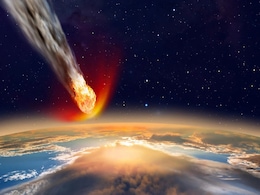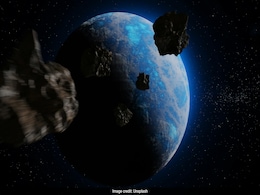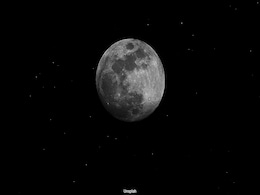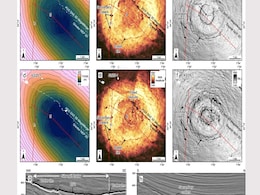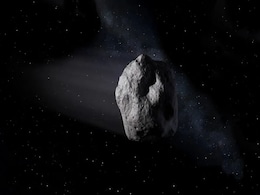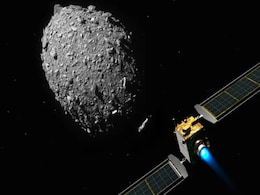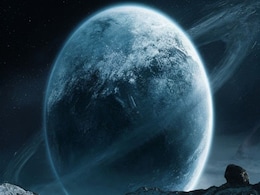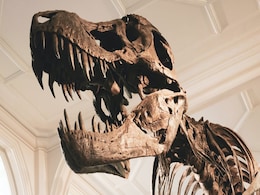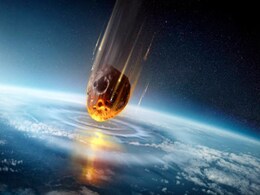Asteroid Crater
- All
- News
-

Scientists Discover Ancient Asteroid Crater Hidden Beneath the Atlantic Ocean
- Tuesday November 4, 2025
- Written by Gadgets 360 Staff
A recent study by researchers from Heriot-Watt University has confirmed the presence of a massive crater beneath the Atlantic. The evidence supports the findings and the impact that was caused by a 66-million-year-old asteroid.
-
 www.gadgets360.com
www.gadgets360.com
-

Mysterious Asteroid Impact Found in Australia, But the Crater is Missing
- Sunday October 19, 2025
- Written by Gadgets 360 Staff
Scientists have identified 11-million-year-old glass fragments in South Australia that record a massive asteroid impact never before known. Despite the event’s magnitude, the crater remains undiscovered, raising new questions about how often large asteroids have struck Earth and their role in shaping its surface.
-
 www.gadgets360.com
www.gadgets360.com
-

Hidden Asteroids Near Venus Pose Long-Term Threat To Earth, Study Reveals
- Thursday October 2, 2025
- Science | Edited by Srishti Singh Sisodia
Some of the asteroids could intersect Earth's path within a few thousand years, posing a collision risk.
-
 www.ndtv.com
www.ndtv.com
-

Scientists Suggest Moon May Hold Large Reserves Of Precious Platinum-Group Metals
- Friday September 26, 2025
- Science | Edited by Nikhil Pandey
A new study reveals that the Moon's impact craters may contain large reserves of platinum-group metals and water, making it a valuable target for future space mining and exploration.
-
 www.ndtv.com
www.ndtv.com
-

Scientists Confirm Ancient Asteroid Impact Created North Sea’s Silverpit Crater 43 Million Years Ago
- Tuesday September 23, 2025
- Written by Gadgets 360 Staff
New research confirms the Silverpit Crater in the North Sea was formed by an asteroid impact around 43 million years ago. Using seismic imaging and rare mineral evidence, scientists proved the impact origin beyond doubt, resolving a debate that lasted two decades and placing the crater among Earth’s rare, well-preserved impact structures.
-
 www.gadgets360.com
www.gadgets360.com
-

78 Million Years Ago, An Asteroid Hit Earth, Then Life Started In Its Crater
- Thursday September 18, 2025
- Science | Edited by Nikhil Pandey
Scientists have discovered that microbial life colonised the Lappajarvi impact crater in Finland shortly after a massive asteroid struck 78 million years ago.
-
 www.ndtv.com
www.ndtv.com
-

Did Something Hit Saturn? Astronomers Investigate Possible Impact Flash
- Wednesday July 9, 2025
- Science | Edited by Amit Chaturvedi
Unlike rocky planets where asteroid impacts leave visible craters, gas giants like Saturn have outer layers of hydrogen and helium that can absorb impacts without obvious traces.
-
 www.ndtv.com
www.ndtv.com
-

Study Reveals Earth's Small Asteroid Likely Originated from the Moon
- Monday January 27, 2025
- Written by Gadgets 360 Staff
Asteroid 2024 PT5, discovered near Earth in 2024, is suspected to be a fragment from the Moon’s surface. Researchers found its composition matches lunar rock samples, specifically silicate-rich materials, unlike any known asteroid. Analysis from NASA’s Center for Near Earth Object Studies confirmed it is a natural object, not human-made debris,...
-
 www.gadgets360.com
www.gadgets360.com
-

Hera Spacecraft Embarks on Mission to Study Asteroid Redirected by NASA in 2022
- Tuesday October 8, 2024
- Written by Gadgets 360 Staff
The Hera spacecraft has successfully launched from Cape Canaveral, embarking on an international mission to study the asteroid Dimorphos, which was altered in course by NASA’s Double Asteroid Redirection Test (DART) in 2022. Expected to reach its target by December 2026, Hera will examine the impact crater left by the DART mission and deploy two ...
-
 www.gadgets360.com
www.gadgets360.com
-

Scientists Reveal It Wasn't Just One Asteroid That Wiped Out Dinosaurs
- Friday October 4, 2024
- Science | Edited by NDTV News Desk
The massive asteroid that ended the dinosaurs 66 million years ago was not an isolated event, new research has revealed.
-
 www.ndtv.com
www.ndtv.com
-

Could Earth Have Had Rings Like Saturn? Study Suggests Asteroid Breakup and Cooling Climate
- Wednesday September 18, 2024
- Written by Gadgets 360 Staff
Scientists have proposed that Earth may once have had a ring system similar to Saturn’s, formed by an asteroid breakup 466 million years ago. This ring may have triggered global cooling, contributing to the Hirnantian Ice Age. Evidence includes impact craters near the equator and meteorite debris in sedimentary rocks.
-
 www.gadgets360.com
www.gadgets360.com
-

Study Of Craters Suggests Earth Once Had Saturn-Like Rings
- Wednesday September 18, 2024
- Science | Edited by Amit Chaturvedi
The study said that the asteroid belt was formed due to the break-up of an asteroid passing within Earth's Roche limit.
-
 www.ndtv.com
www.ndtv.com
-

Asteroid Impact Reoriented Jupiter’s Largest Moon Ganymede 4 Billion Years Ago
- Sunday September 8, 2024
- NDTV
A colossal asteroid impact about 4 billion years ago dramatically altered Ganymede, Jupiter's largest moon. The asteroid, estimated to be 186 miles wide, struck Ganymede with such force that it reoriented the moon and removed a significant portion of its original surface. This impact not only created a massive crater but also affected Ganymede's in...
-
 www.gadgets360.com
www.gadgets360.com
-

Apart From Chicxulub, Another Asteroid Might Have Contributed to Dinosaur Extinction
- Thursday August 18, 2022
- Edited by Gadgets 360 Newsdesk
A mysterious asteroid impact crater have been spotted on the seafloor which is believed to have formed at the same time when dinosaurs were wiped out from the planet. This could mean that not one, but two asteroid impacts were behind the extinction of dinosaurs.
-
 www.gadgets360.com
www.gadgets360.com
-

Scientists Discover Undersea Crater Created When Dinosaurs Disappeared
- Thursday August 18, 2022
- Science | Edited by Amit Chaturvedi
The researchers have named the other crater as Nadir. It is more than 300 metres below the seabed, some 400 km off the coast of Guinea.
-
 www.ndtv.com
www.ndtv.com
-

Scientists Discover Ancient Asteroid Crater Hidden Beneath the Atlantic Ocean
- Tuesday November 4, 2025
- Written by Gadgets 360 Staff
A recent study by researchers from Heriot-Watt University has confirmed the presence of a massive crater beneath the Atlantic. The evidence supports the findings and the impact that was caused by a 66-million-year-old asteroid.
-
 www.gadgets360.com
www.gadgets360.com
-

Mysterious Asteroid Impact Found in Australia, But the Crater is Missing
- Sunday October 19, 2025
- Written by Gadgets 360 Staff
Scientists have identified 11-million-year-old glass fragments in South Australia that record a massive asteroid impact never before known. Despite the event’s magnitude, the crater remains undiscovered, raising new questions about how often large asteroids have struck Earth and their role in shaping its surface.
-
 www.gadgets360.com
www.gadgets360.com
-

Hidden Asteroids Near Venus Pose Long-Term Threat To Earth, Study Reveals
- Thursday October 2, 2025
- Science | Edited by Srishti Singh Sisodia
Some of the asteroids could intersect Earth's path within a few thousand years, posing a collision risk.
-
 www.ndtv.com
www.ndtv.com
-

Scientists Suggest Moon May Hold Large Reserves Of Precious Platinum-Group Metals
- Friday September 26, 2025
- Science | Edited by Nikhil Pandey
A new study reveals that the Moon's impact craters may contain large reserves of platinum-group metals and water, making it a valuable target for future space mining and exploration.
-
 www.ndtv.com
www.ndtv.com
-

Scientists Confirm Ancient Asteroid Impact Created North Sea’s Silverpit Crater 43 Million Years Ago
- Tuesday September 23, 2025
- Written by Gadgets 360 Staff
New research confirms the Silverpit Crater in the North Sea was formed by an asteroid impact around 43 million years ago. Using seismic imaging and rare mineral evidence, scientists proved the impact origin beyond doubt, resolving a debate that lasted two decades and placing the crater among Earth’s rare, well-preserved impact structures.
-
 www.gadgets360.com
www.gadgets360.com
-

78 Million Years Ago, An Asteroid Hit Earth, Then Life Started In Its Crater
- Thursday September 18, 2025
- Science | Edited by Nikhil Pandey
Scientists have discovered that microbial life colonised the Lappajarvi impact crater in Finland shortly after a massive asteroid struck 78 million years ago.
-
 www.ndtv.com
www.ndtv.com
-

Did Something Hit Saturn? Astronomers Investigate Possible Impact Flash
- Wednesday July 9, 2025
- Science | Edited by Amit Chaturvedi
Unlike rocky planets where asteroid impacts leave visible craters, gas giants like Saturn have outer layers of hydrogen and helium that can absorb impacts without obvious traces.
-
 www.ndtv.com
www.ndtv.com
-

Study Reveals Earth's Small Asteroid Likely Originated from the Moon
- Monday January 27, 2025
- Written by Gadgets 360 Staff
Asteroid 2024 PT5, discovered near Earth in 2024, is suspected to be a fragment from the Moon’s surface. Researchers found its composition matches lunar rock samples, specifically silicate-rich materials, unlike any known asteroid. Analysis from NASA’s Center for Near Earth Object Studies confirmed it is a natural object, not human-made debris,...
-
 www.gadgets360.com
www.gadgets360.com
-

Hera Spacecraft Embarks on Mission to Study Asteroid Redirected by NASA in 2022
- Tuesday October 8, 2024
- Written by Gadgets 360 Staff
The Hera spacecraft has successfully launched from Cape Canaveral, embarking on an international mission to study the asteroid Dimorphos, which was altered in course by NASA’s Double Asteroid Redirection Test (DART) in 2022. Expected to reach its target by December 2026, Hera will examine the impact crater left by the DART mission and deploy two ...
-
 www.gadgets360.com
www.gadgets360.com
-

Scientists Reveal It Wasn't Just One Asteroid That Wiped Out Dinosaurs
- Friday October 4, 2024
- Science | Edited by NDTV News Desk
The massive asteroid that ended the dinosaurs 66 million years ago was not an isolated event, new research has revealed.
-
 www.ndtv.com
www.ndtv.com
-

Could Earth Have Had Rings Like Saturn? Study Suggests Asteroid Breakup and Cooling Climate
- Wednesday September 18, 2024
- Written by Gadgets 360 Staff
Scientists have proposed that Earth may once have had a ring system similar to Saturn’s, formed by an asteroid breakup 466 million years ago. This ring may have triggered global cooling, contributing to the Hirnantian Ice Age. Evidence includes impact craters near the equator and meteorite debris in sedimentary rocks.
-
 www.gadgets360.com
www.gadgets360.com
-

Study Of Craters Suggests Earth Once Had Saturn-Like Rings
- Wednesday September 18, 2024
- Science | Edited by Amit Chaturvedi
The study said that the asteroid belt was formed due to the break-up of an asteroid passing within Earth's Roche limit.
-
 www.ndtv.com
www.ndtv.com
-

Asteroid Impact Reoriented Jupiter’s Largest Moon Ganymede 4 Billion Years Ago
- Sunday September 8, 2024
- NDTV
A colossal asteroid impact about 4 billion years ago dramatically altered Ganymede, Jupiter's largest moon. The asteroid, estimated to be 186 miles wide, struck Ganymede with such force that it reoriented the moon and removed a significant portion of its original surface. This impact not only created a massive crater but also affected Ganymede's in...
-
 www.gadgets360.com
www.gadgets360.com
-

Apart From Chicxulub, Another Asteroid Might Have Contributed to Dinosaur Extinction
- Thursday August 18, 2022
- Edited by Gadgets 360 Newsdesk
A mysterious asteroid impact crater have been spotted on the seafloor which is believed to have formed at the same time when dinosaurs were wiped out from the planet. This could mean that not one, but two asteroid impacts were behind the extinction of dinosaurs.
-
 www.gadgets360.com
www.gadgets360.com
-

Scientists Discover Undersea Crater Created When Dinosaurs Disappeared
- Thursday August 18, 2022
- Science | Edited by Amit Chaturvedi
The researchers have named the other crater as Nadir. It is more than 300 metres below the seabed, some 400 km off the coast of Guinea.
-
 www.ndtv.com
www.ndtv.com


